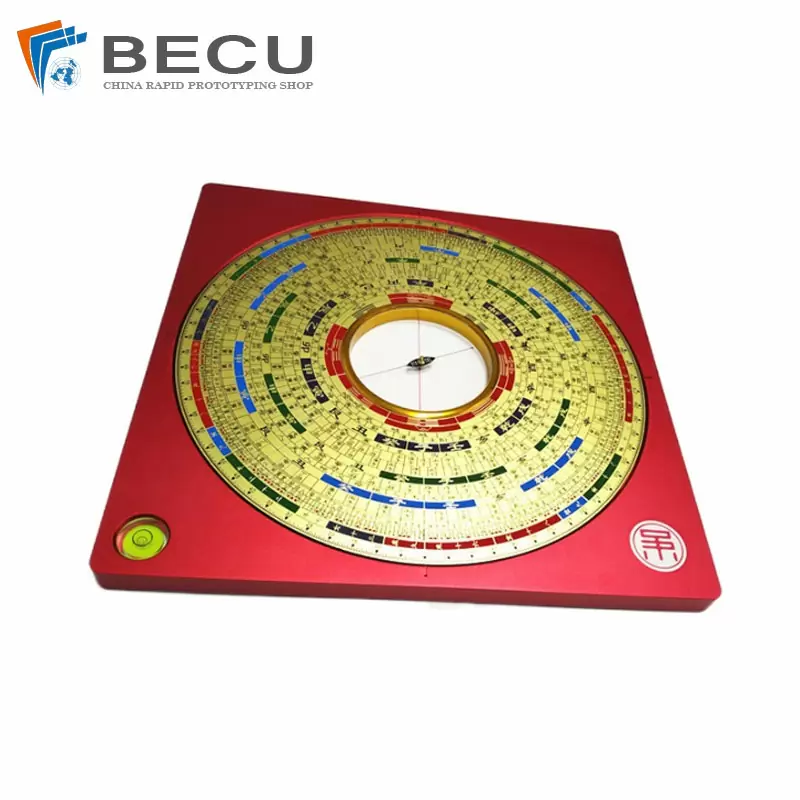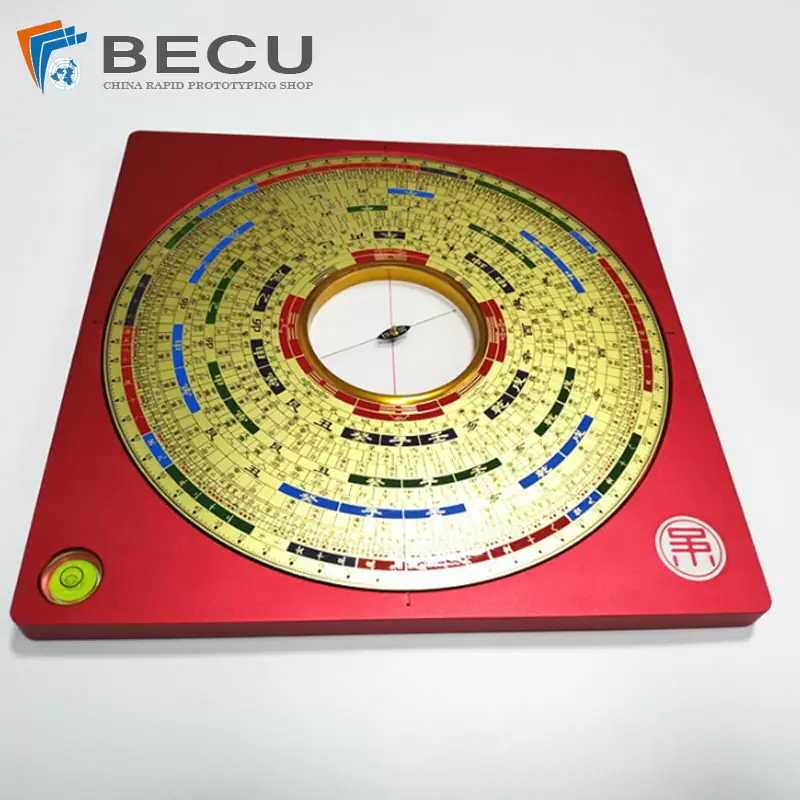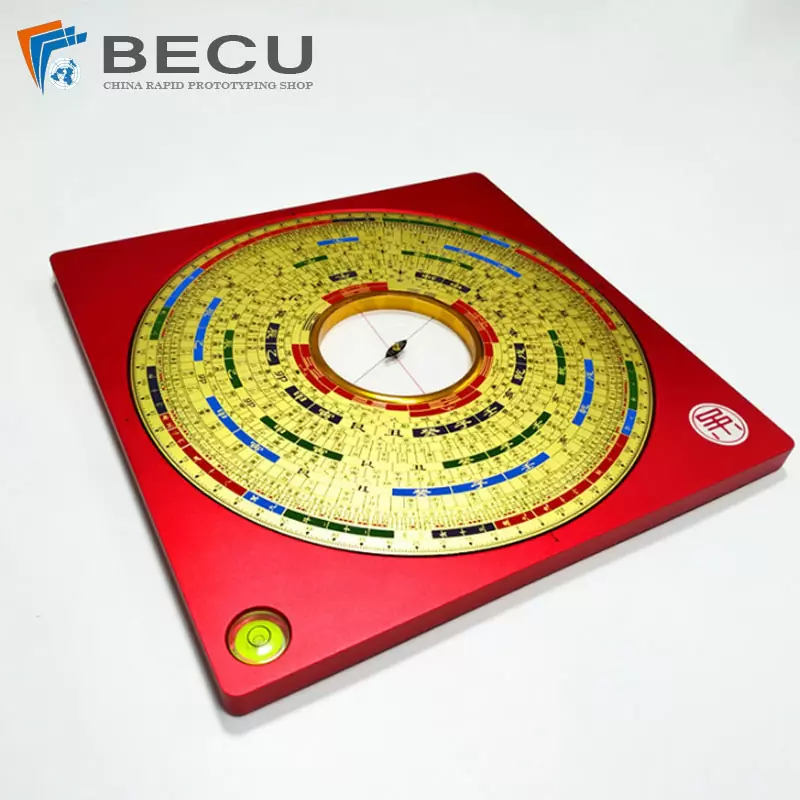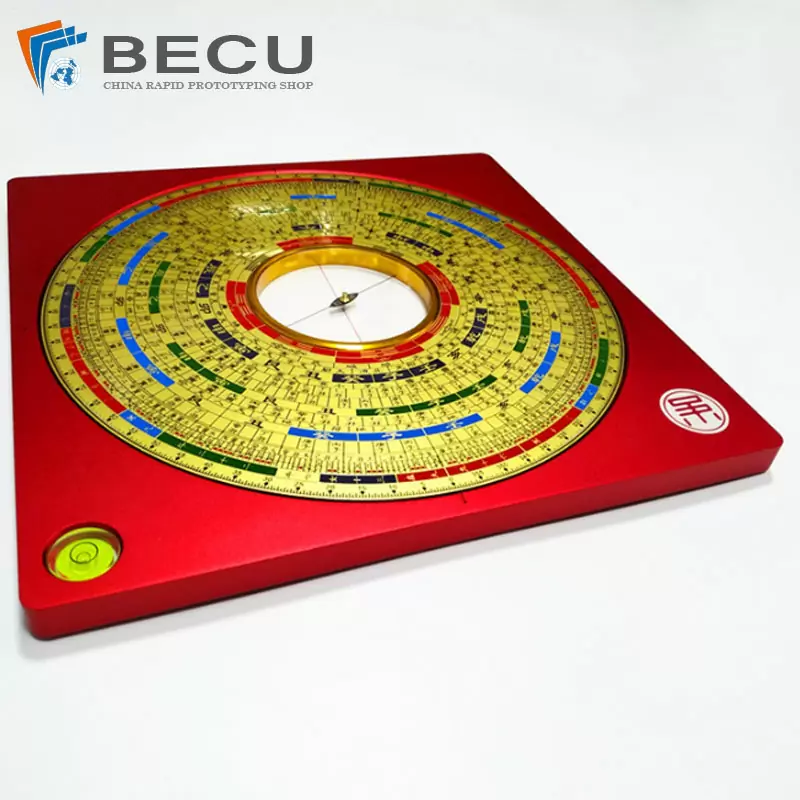Feng Shui Compass
- Color: Custom
- Surface Treatment: Oxidation
- Product Material: Aluminum Alloy
- Proofing Cycle: 7 days(100000 pcs/M)
- Application: Cnc Machining
- machining Factory: Be-cu Rapid Prototyping Companies
- Product Category: Feng Shui Compass
- Production Process: Cnc Milling
- Size: According To Customer’s Drawings
What Is Chinese Antique Feng Shui Compass
The Chinese Antique Feng Shui compass, also known as the Feng Shui compass instrument, is a tool used for feng shui detection and a commonly used operating tool in the qi sect. The compass is mainly composed of a magnetic needle at the center of the disk and a series of concentric circles, each of which represents the ancient Chinese people’s understanding of a certain level of information in the large system of the universe.
The ancient Chinese believed that the aura of man is controlled by the aura of the universe. Harmony between man and the universe is auspicious, and disharmony between man and the universe is evil. Therefore, based on their experience, they put information at all levels in the universe, such as the stars in the sky, all things represented by the five elements on the earth, the heavenly stems and the earthly branches, etc., all on the compass. [1] Feng shui masters use the rotation of the magnetic needle to find the most suitable position or time for a specific person or specific event. Although the concept of “magnetic field” is not mentioned in feng shui, the coordination of direction, orientation and interval between the various circles on the compass implies the law of “magnetic field”.
High-Quality Custom Cnc Machining Chinese Antique Feng Shui Compass
CNC Machining services for Chinese Antique Feng Shui Compass. Various processes include broaching, threading, internal forming, knurling, boring, drilling, counterboring, countersinking, pocketing, profiling, reaming, tapping, thread milling and gun drilling. Prototype and high volume production offered. Suitable for valves, pins, shafts, bushings, spacers, fasteners and fittings. Serves the aerospace, military and defense, oil and gas, agriculture, HVAC, hydraulic and ordnance industries. AutoCAD and SolidWorks® files accepted. Meets AS9100C standards. ITAR registered. On-time delivery. Contract manufacturing and machining services are supported by LEAN, ERP, EDI, Kanban, Consignment and GSCM. Advanced manufacturing and business practices such as Professional Program Management, new product co-development, DFM assessments, single point of contact global and domestic supply chain management are available for applicable projects.
The Advantages Of Custom Chinese Antique Feng Shui Compass
- – Excellent wear and impact resistance
- – Durable and solid, long lifetime
- – Good strength and electrical conductivity
- – Customization based on customer specification
Specifications of Custom Chinese Antique Feng Shui Compass
| Material | 6063 Aluminum |
| Tolerance | +/-0.05mm |
| Surface Treatment | Custom |
| Main Process | Swiss Machining,Cnc Turning, Drilling, 5 Axis Cnc Machining |
| Quality Control | Strictly Quality control in the whole process, from material to packing, Coordinate-measuring machine |
| Usage | Feng Shui Compass |
| Customized Drawings | Auto CAD, JPEG, PDF, STP, IGS, and most other file formats are accepted |
The Structure Of Chinese Antique Feng Shui Compass
The compass consists of three parts:
Tianchi
Also called the bottom of the sea, that is, the compass. The Tianchi of the compass consists of a thimble, a magnetic needle, a submarine line, a cylindrical outer box, and a glass cover, which are fixed in the center of the inner disk. There is a pointed thimble in the center of the bottom surface of the round box, and there is a concave hole in the center of the bottom surface of the magnetic needle, and the magnetic needle is placed on the thimble. The end of the compass with the arrow points to the south, and the other end points to the north.
There is a red line drawn on the bottom surface (seabed) of Tianchi, called the seabed line. There are two red dots on both sides of the north end. When using it, the north end of the magnetic needle should be coincident with the seabed line.
The seabed of the modern compass is drawn with a cross line, and the top of the cross line is printed with east, west, northwest, and northwest.
Inner Compass
It’s the rotating disc just outside the compass. There are many concentric circles printed on the inner disk, and one circle is called a layer. Each layer is divided into different equal parts, some layers have more grids, some have fewer grids, the least is divided into eight grids, and the layer with the most grids has 384 grids. Different characters are printed on each grid. There are many types of compasses, some have more layers, some have fewer layers, the most has fifty-two layers, and the least has only five layers.
The various contents of the compass are imprinted on different circles (layers) of the inner disk, which are the main components of the compass. The main contents of each school of Feng Shui are listed on the compass, making the Chinese compass an encyclopedia of Chinese magic.
Outer Compass
The outer disk is a square, which is the tray of the inner disk. There are small holes at the midpoints of the outer sides of the four sides, and the red lines are penetrated to become the Tianxin Ten Dao, which is used to read the content on the inner disk. The Ten Paths of Tianxin are required to be perpendicular to each other, and the newly purchased compass must be calibrated before use.
The compass is a basic tool for measuring the magnetic azimuth of the earth’s surface, and is widely used in various fields such as military, navigation, surveying and mapping, forestry, exploration, and construction.
The compass is actually a tool used to measure the position of the ground using the compass positioning principle. The compass is used in Feng Shui for Gelong, sand elimination, water storage and determination of the sitting direction of buildings.
The Type Of Chinese Antique Feng Shui Compass
There are three types of compasses on the market today, namely the three-element compass, the three-in-one compass and the three-element three-in-one comprehensive compass. When learning Feng Shui, choose the three-element three-in-one comprehensive compass.
The shape of the compass is an inner circle and an outer square, and the inner circle in the compass can be rotated. There must be a 360° scale around the inner circle and there are two fixed cross latitude and longitude lines on the four sides of the outer circle.
Because there are many feng shui schools and there are differences between them, the compasses used by them are also different, so the compasses are divided into many types. The comprehensive plate that is common to the pie and the Sanhe faction – the Sanyuan Sanhe dual-purpose plate.
Among them, the Sanyuan plate is also called “Jiang Pan”, and there are innate and acquired gossips on the plate, a total of 64 hexagrams. “Yanggong Pan”, there are three layers and twenty-four mountain directions on the pan.
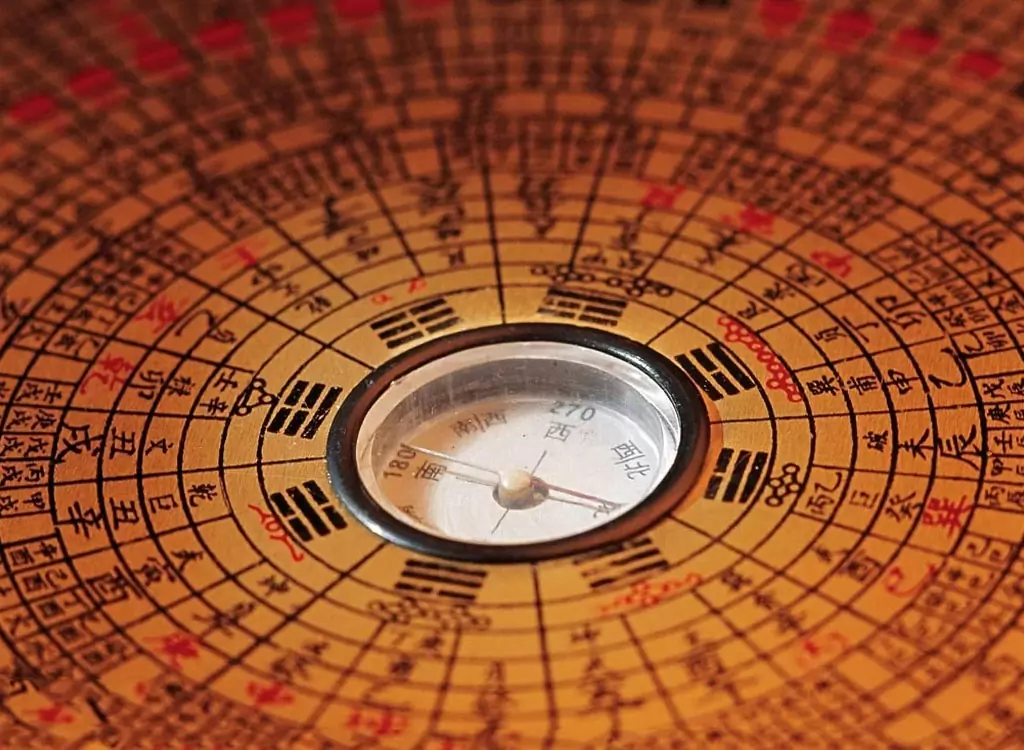
The Situation School mainly uses the ternary pan, and the Li Qi style usually uses the three-complex pan, but modern Feng Shui is mostly a combination of the situation and the Li Qi, so most of the comprehensive pans are used.Other common compasses There are also Yipan, Xuankongpan and the unique pans used by each school, but no matter which school of compass it is, there must be a layer in the middle with the orientation of the twenty-four mountains. Starting from the north, the order is Renzigui, Chou Genyin, Jiamaoyi, Chenxunsi, Bingwuding, Weikunshen, Gengyouxin, Xuganhai twenty-four.
In terms of the origin of compasses in my country, Taiwan is the best, followed by Hong Kong and mainland China. If a beginner does not have a compass, it is recommended that you buy a compass made in mainland first. If there is a chance in the future If so, you must buy a compass made in Taiwan. The compass made in mainland China cannot be compared with the compass made in Taiwan in terms of the feel of rotation and the accuracy of the magnetic needle. Therefore, when buying a compass, it is best to find a compass with a more accurate magnetic needle to check the accuracy of the magnetic needle or 360° scale. See Check if there is any deviation in the degree of the magnetic needle when measuring objects in the same orientation.
The History Development Of Chinese Antique Feng Shui Compass
In the book “Machine, Natural Forces and the Application of Science”, Marx said: “The compass (compass) opened up the world market and established colonies.” This invention of the ancient Chinese was first used in navigation, and it was very important to the emergence and development of capitalism. It did help to some extent. Magnetic needles are used for navigation, turning three-quarters of the earth’s seas into channels. Since the 15th century, Columbus sailed across the Atlantic to reach the American continent; at the beginning of the 16th century, the successful circumnavigation of Magellan’s fleet was inseparable from the application of the magnetic needle. But when and how the magnetic needle was introduced to Europe has been debated by international scholars for hundreds of years. Engels came to a scientific conclusion on this in his Dialectics of Nature, stating that “the magnetic needle was passed by the Arabs” from China “to the Europeans,” “around 1180.”
The predecessor of the compass was called “Sinan”, and the earliest record was found in “Han Feizi Youdu” in the third century BC. At that time, when people talked about the phenomenon of magnet attracting iron, they thought it meant “a loving mother and child”, so they once wrote “magnetic” as “ci”.

Sinan is like a household spoon, the bottom is hemispherical, in order to reduce friction and easy to rotate when it is placed on the plate engraved with the “dry branch” scale. In the Song Dynasty in the 12th century AD, Zhu Yu talked about the compass used for navigation in “Pingzhou Ke Tan” and Xu Jing in “Korean Book of Pictures”. Some people say that the navigation compass is still too early, because according to the records of Liang Shenyue of the Southern Dynasty, there were already “compass boats” in the Jin Dynasty. (According to Japan, in the fourth year of Emperor Qiming’s fourth year (Tang Gaozong Xianqing three years, AD 658), the secretary said: “Abe led Tianchen Hirafu to crusade Sushen (Bohai Kingdom) – Shaman Zhiyu built a guide car The guide car was used for the crusade against Sushen at sea. At that time, Hirafu led 180 boats on the expedition. In the same book, in the sixth year of Emperor Tianzhi (the second year of Emperor Gaozong of the Tang Dynasty, 667 AD), he said: “The Japanese and Han Shamen Zhiyouxian Compass car.” “Japanese monks” refers to Chinese monks who were naturalized in Japan.) In the Southern Song Dynasty, an independent instrument compass (a device that uses a compass to indicate the direction of the magnetic meridian is called a compass) was made, which was widely used in navigation.
The book that introduced the compass in the West was first seen in the early 13th century, which was 100 years later than the records in Pingzhou Ketan and other books. Shen Kuo’s “Mengxi Bi Tan” in the Song Dynasty recorded the declination of the water-floating needle and the magnetic needle. Columbus discovered the declination of the magnetic needle when he first crossed the Atlantic Ocean, more than 400 years later than Shen Kuo’s record. In modern times, the liquid magnetic compass is commonly used on ships of various countries, which is an important creation in navigation technology. This design is based on the European traditional dry compass, and absorbs the technology of floating needle in my country for 800 years, so that the magnetic compass is becoming more and more perfect. This should be an important achievement of scientific and technological exchanges between China and the West.
Before the invention of the compass, the ancients used the stars to determine the orientation. At night, they determined the orientation by observing the North Star, and during the day, they determined the orientation through the shadow of the sun. Very early, our ancestors invented the compass car.
Before the invention of the compass, it was impossible to divide the ground position very finely. Only eight major directions of north, northeast, east, southeast, south, southwest, west, and northwest can be used to describe the direction and orientation. In Feng Shui, gossip is used to represent: Kan hexagram represents the north, Gen hexagram represents the northeast, Zhen hexagram represents the east, Xun hexagram represents the southeast, Li hexagram represents the south, Kun hexagram represents the southwest, Dui hexagram represents the west, and Qian hexagram represents the northwest. square.
Classic Compass
With the development of the processing industry, the magnetic needle changed from the original spoon shape to the needle shape, and from the water-floating magnetic needle to the thimble, which made a qualitative change in the measurement accuracy of the compass. In the Tang Dynasty, Yang Junsong combined the eight trigrams and the twelve earthly branches into one positioning system, and added the ten days of A, B, C, D, Wu, Ji, Geng, Xin, Ren, and Gui to indicate the position of the central palace. Except for E and Hexane, all of them are added to the ground azimuth system to indicate the azimuth.
Therefore, the three hundred and sixty degrees of the horizon and the sky are divided into twenty-four equal parts, called twenty-four mountains, each mountain occupies 15 degrees, and three mountains are one hexagram, and each hexagram accounts for forty-five degrees.
Twenty-Four Mountains has been preserved since it was created in the Tang Dynasty. Therefore, the site twenty-four hills is one of the main levels of Yangpan. The three mountains in the north are Ren, Zi, and Gui, the Houtian belongs to the Kan hexagram, and the innate belongs to the Kun hexagram; the three mountains in the northeast belong to the Chou, Gen, and Yin, the acquired day belongs to the Gen hexagram, and the innate belongs to the Zhen hexagram;
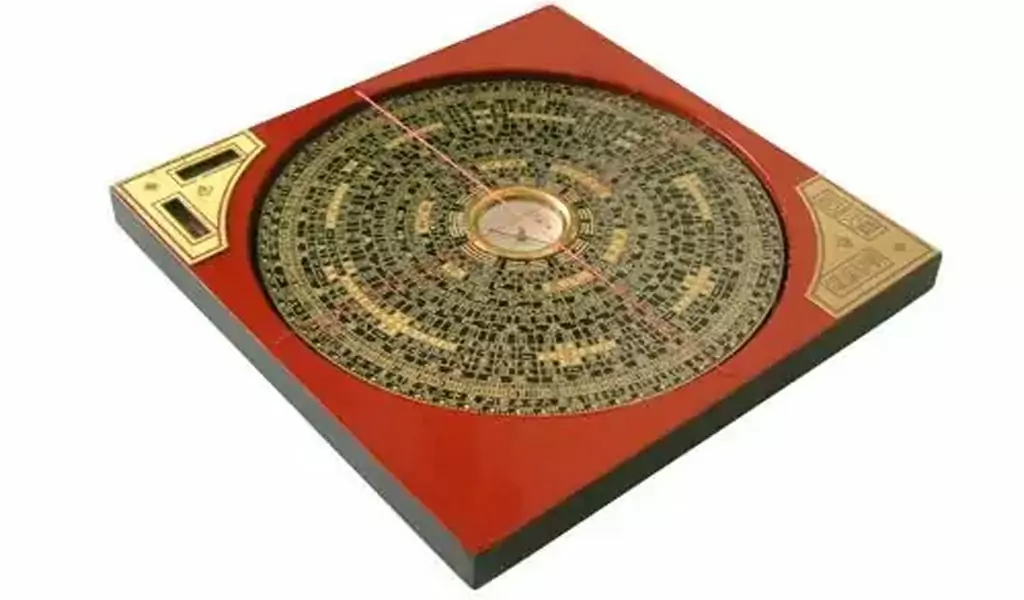
The three mountains in the east, Jia, Mao, and B, belong to the Zhen hexagram of the acquired day, and the Li hexagram of the innate; the three mountains of the southeast, Chen, Xun, and Si, the acquired hexagram of the Sun, and the congenital of the Dui hexagram;
The three mountains Bing, Wu, and Ding in the south belong to the Li Gua, and the Xiantian belongs to the Qian Gua; the three mountains in the southwest are Wei, Kun, and Shen, and the Houtian belongs to the Kun Gua, and the Xiantian belongs to the Sun Gua; the western three mountains are Geng, You, and Xin. It belongs to the Kan hexagram; the three mountains in the northwest are Xu, Gan, and Hai, the acquired day belongs to the Qian hexagram, and the congenital belongs to the Gen hexagram.
Yang Compass
Yang Gong, as the ancestor of Yang Gong Feng Shui in southern Jiangxi, not only created a complete Feng Shui theory, but also made a reasonable transformation of the compass tool of Feng Shui.

The Twenty-Four Mountain Pan of the site was created by Duke Yang. Before Duke Yang, there was no complete Twenty-Four Mountain Pan, only the Eight Trigrams Pan and the Twelve Earthly Branches Pan.
Although the compasses of the Han Dynasty also had the marks of the eight trigrams, the earthly branches and the heavenly stems, they did not divide the degrees equally, but divided the heavenly stems, the eight trigrams and the twelve earthly branches into three layers, and their degrees were inconsistent. Yang Gong rearranged it and completely distributed the Eight Diagrams, Heavenly Stems and Earthly Branches in the plane orientation, which was an epoch-making creation.
The constellation plate on the twenty-four hills of the site, the seventy-two dragon plate, was created by Yang Gong in his later years. Through his long-term practice, Yang Gong found that yin and yang and five elements generally exist in all directions. The distribution of yin and yang and five elements is determined according to the attributes of gossip and five elements, which is inconsistent with the actual situation. Heavenly stems, using the five elements of Nayin to express the attributes of the five elements of the dragon, called “upside down” the five elements. “Upside down, twenty-four mountains have jewels; upside down, twenty-four mountains have fire pits” in “Qing Nang Ao Yu”, the “upside down” mentioned in “upside down” refers to the five elements of Nayin of the seventy-two dragons.
Han Dynasty Compass
The Tianpan was also created by Duke Yang. Yang Gong found that there was a large error in using the land to absorb water in the practice of Kanyu. According to the principle of the left-handed rotation of the heaven and the right-handed of the tunnel, he created the Tianpan Shuangshan to eliminate sand and absorb water. In the compass, only the celestial pan has double mountains, and the other pans do not have double mountains. The ancients believed that the dragon came from the sky, belonged to the heaven system, and was yang. Water flows in the middle of the earth, belongs to the earth system, and is yin. Due to the displacement effect caused by the relative motion of the left and right rotation of the heaven and the earth, the celestial plate used to hold water should be moved to the right, so Yang Gong rotated and shifted it to the right by 7.5° in the orientation of the earth.
The Five Elements of Shuangshan are the three elements and the five elements. Tianpan and Renzi are in the same palace, Gui Chou is in the same palace, Genyin is in the same palace, Jiamao is in the same palace, Yichen is in the same palace, Xunsi is in the same palace, Bingwu is in the same palace, Dingwei is in the same palace, and Kun is in the same palace. Shen is the same palace, Gengyou is the same palace, Xin Xu is the same palace, and Ganhai is the same palace. The center of the twin mountains is directly opposite the center of the twelve Earthly Branches of the site.
The twelve earthly branches are organized according to the three-combination bureau of Shengwang Tomb, namely, Shenzichen three-height water bureau, Yinwuxu three-height fire bureau, Siyouchou three-helix bureau, and Haimaowei three-height wood bureau. Chenxu Chouwei is the tomb of water, fire, metal, and wood, and it is an important place for the yin and yang of Longshui to copulate.
Therefore, the combination of the earth, the sky and the seventy-two dragons is commonly known as “Yangpan”.
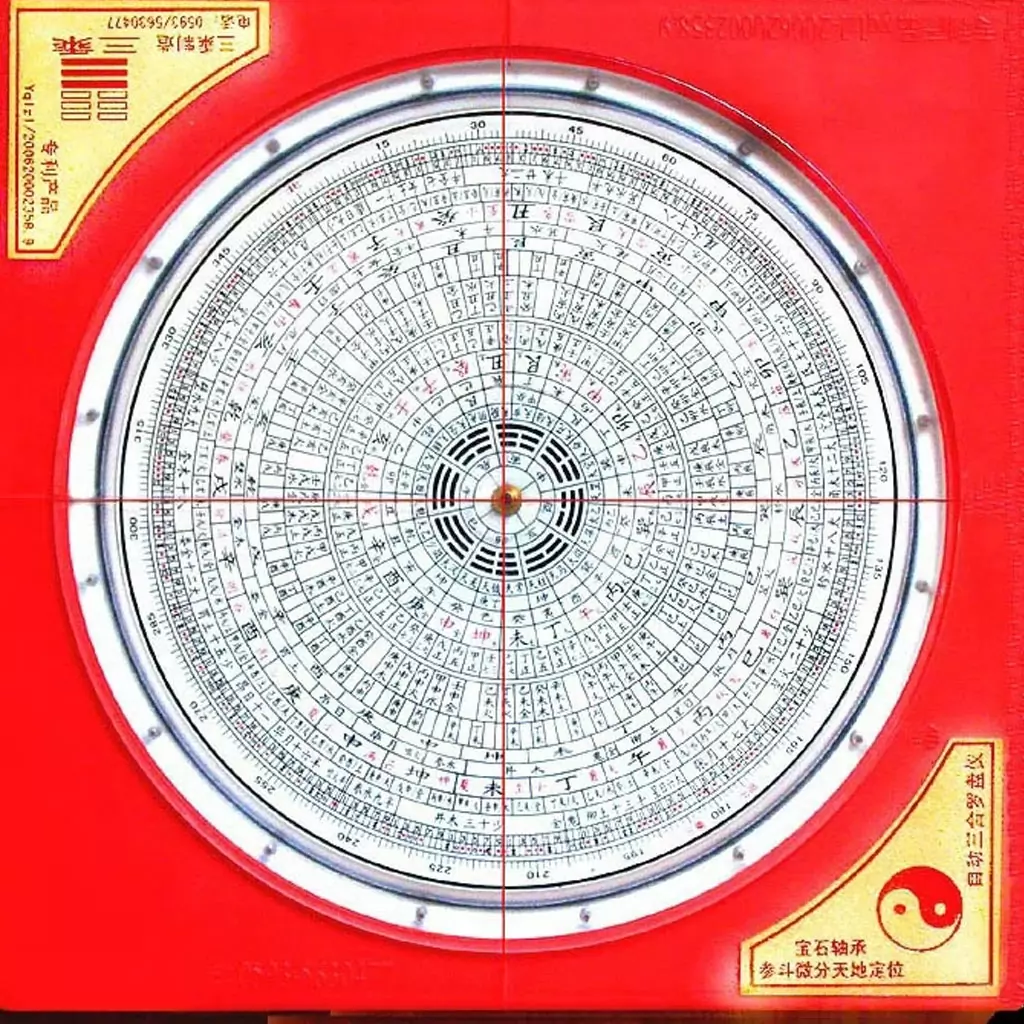
Later, in the Song Dynasty, Lai Buyi introduced the 28 Stars and Five Elements, and added a human plate, which was specially used to eliminate sand and remove evil. The twenty-four hills of the human disk are rotated 7.5 degrees counterclockwise compared to the twenty-four hills of the site. The human disk is also called “Lai disk”.
The Basic Theory Of Chinese Antique Feng Shui Compass
The ancient Chinese believed that the aura of man is controlled by the aura of the universe. Harmony between man and the universe is auspicious, and disharmony between man and the universe is evil. Therefore, based on their experience, they put information at all levels in the universe, such as the stars in the sky, all things represented by the five elements on the earth, the heavenly stems and the earthly branches, etc., all on the compass. Feng shui masters use the rotation of the magnetic needle to find the most suitable location or time for a specific person or specific event.
Although the concept of “magnetic field” is not mentioned in feng shui, the coordination of direction, orientation and interval between the various circles on the compass implies the law of “magnetic field”.
The invention and application of the compass is the result of mankind’s continuous exploration of the mysteries of the universe, society and life. The increasing number of circles on the compass and the increasingly complex pointer system represent the accumulated practical experience of human beings. Of course, whether these experiences are comprehensive and correct still needs further study, but the information marked on the compass contains a lot of ancient Chinese wisdom.
The Real-World Application Of Chinese Antique Feng Shui Compass
The compass is the tool of the feng shui master, and it can be said that it is the job of the feng shui master. Each master will pass on the most important mantle and secrets to his favorite disciples before he dies. The compass is also one of the Guru’s heritage. Master’s teaching of the Fa and the mantle of his disciples prove that he has handed over his life’s efforts, expectations and full burdens to his disciples, which is usually referred to as handing over his rice bowl to his disciples in the Jianghu industry, hoping to continue his legacy and carry forward it.
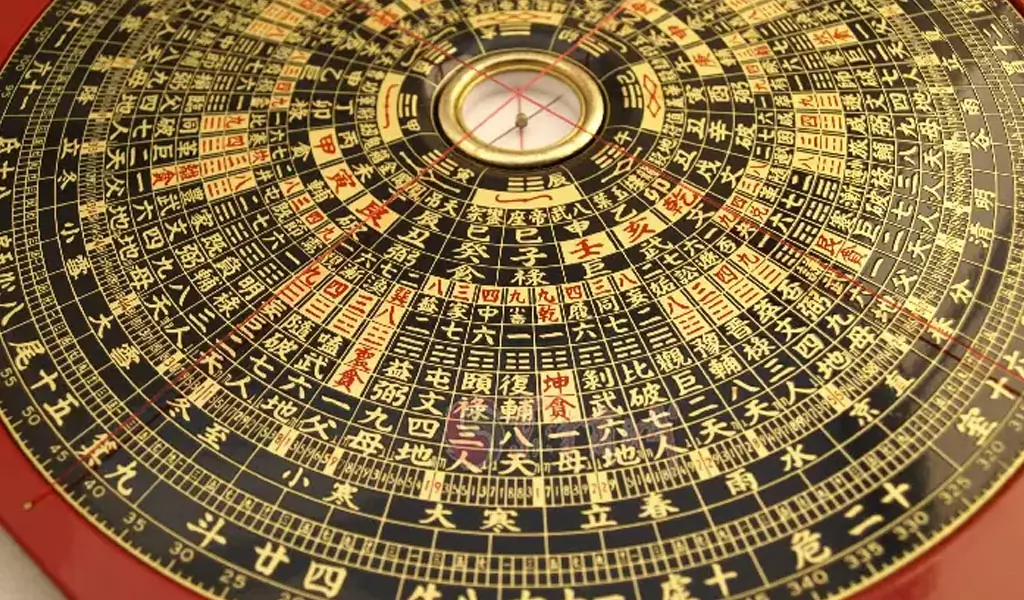
If a feng shui practitioner, whether it is a famous teacher or a new feng shui apprentice, if he does not have the mantle of a master, he does not have the key technical secrets of the master, and usually does not have the qualifications for direct inheritance. In the words of Jianghu, it is “Piao Xue”, that is, a gentleman who debuted halfway, or a self-study library.
This kind of gentleman who has not been trained by a teacher can simply test some feng shui of the Yang house or the feng shui of the yin grave. But when doing feng shui, you have to be careful, because breaking feng shui and doing feng shui are completely different things.
There are many ways to break feng shui, such as gossip, qimen, heart change method, witchcraft, etc., and to do feng shui, you must have excellent and complete feng shui techniques. Usually, only by inheritance can you get the feng shui that controls the misfortune of life and turns the world around. Skills and Mysteries. Especially in the yin and yang burial feng shui, you must be careful. Without strong yin and yang feng shui skills, you must not arbitrarily bury people for others, so as not to damage the blessings of others. Yin house feng shui kills and damages people with tragic disasters, ranging from genocide to small casualties, which can be seen within a hundred days.
Most people think that the main function of the compass is to use it only for viewing the house. After the measurement is completed, it is released. In fact, the compass has many other important feng shui functions:
1.Soothe The Nerves:
Putting the compass under a thick pillow can play a role in calming the house, warding off evil spirits, and soothing the nerves, allowing you to sleep well and rest assured that it will not be crushed. However, it is only useful to put the compass on a pillow made of buckwheat hulls, such as pillows made of fabric, linen and cotton, the effect is not good. People who used to sleep with a buckwheat hull pillow against a compass have a particularly high level of thinking. You can use a smaller compass, about three inches, not a big one.
2.Aphrodisiac:
Hold the compass upright and let the oil of the spirit level run to the top. On the night of the fifteenth and sixteenth full moon, hold it towards the full moon and tilt it at an angle of 30 degrees. The moon said: “Qingqing, please come quickly.” After a while, Qingqing came to you. This is the biggest tool for urging peach blossoms. It means “unity of the sun and the moon”. The compass is the sun and the full moon is the moon, but it must be a full moon, which means that the sun and the moon are in the same position. If it is the first quarter moon, Most of those who urge are short-tempered, while the last quarter moon urges those who are depressed. Many people don’t know this. In fact, the compass has many functions of warding off evil spirits, urging peach blossoms, and urging wealth, but most people don’t use it.
3.Increase Wealth Luck:
Hold the compass in one hand, place it at the height of the chest and abdomen, slowly turn the hand while slowly raising it to the height of the neck, transition from bottom to top, and do this repeatedly, this will increase wealth. It’s called “Wonderful”. After one hand is finished, switch to the other hand and do the same thing. It can be done at any time, and it is especially good to do it like this every day. However, it is necessary to ensure that the cross Tianxin line must be adjusted to the right position of the Meridian and the Meridian. , futures, but this kind of money has to do good deeds.
4.”Playing” To Increase The Luck:
Hold the corner of the compass with one hand, enter from the side with the other hand, and tap the bottom of the compass to make a bottom. This is for luck, but don’t push too hard. I used to do this every day, reading Tang poetry and Song poetry while knocking on the plate. Five minutes a day can help increase my luck.
5.”Yin And Yang Turntable”:
Holding the compass and turning it clockwise, the inner disk does not move, the outer disk is turned upside down, it is to help you get rid of bad luck, and it is helpful to solve troubles, and try to do it in the center of the house, where the aura is the hardest.
6.Step On The Plate:
Think of it as a scale, put it on the ground, and step on it with your bare feet. The purpose of stepping on the plate is to prevent you from encountering robbers and robbery on the road. “Treading” through “cai” will give you all the blessings in the plate, and the essence of the plate will be collected to prevent you from going astray and encountering disasters and troubles. But the whole family can’t step on it, but whoever uses this plate and who steps on it, it will be disrespectful for others to step on it. And you can’t step on it easily. It will take a long time for you to get used to it before it is willing to let you step on it.
7.Hold The Plate:
The compass can also be held like a book, and Tianchi can be placed at the position of Tanzhong point (at the midline in front of the body, in the middle of the line connecting the two nipples), which is to prevent heart disease and blood disease and is beneficial to health.
8.”Good Day Ahead”:
When not in use, the position of the compass is also useful. It is not good to place it too high or too low. I generally recommend placing it vertically between the two wooden cabinets. Cover it with a red casing, which means ” Good days come first”, there will always be good days, you must show red, if you hide it, it will not be conducive to good days. It can be placed in the living room, study, but not in the bedroom.
Feng Shui Knowledge Network Warm Tips: Know that the compass has these functions. In addition, there is a layer of 64 hexagrams on the compass. Find the two hexagrams, Ganweitian and Tianfengjian, which are referred to by “Wu”. From here, start reading circle by circle and read every day, which can increase your memory.
What Is Feng Shui Tools
The quality of the tool is related to the accuracy of measurement and directly affects the accuracy of vertical layout. Therefore, in order to do good feng shui, you must know what kind of compass to use in practice. When purchasing a compass, follow the requirements detailed below.
The compass is composed of three parts: the seabed, the inner disc, and the outer disc. The quality of the three parts is closely related to the measurement accuracy of the compass. The Chinese Fengshui Association has positioned the compass as a geographic survey product.
Seabed
- The garden box on the seabed should be a standard cylindrical shape, and the positioning cross line at the bottom of the seabed should be orthogonal, that is, at a 90-degree angle.
- The thimble should be fixed at the intersection of the cross line on the seabed and perpendicular to the bottom of the seabed. The tip of the thimble should not be damaged. If the tip is damaged, the rotation of the magnetic needle will be inflexible.
- The magnetic needle must be straight, with sufficient magnetism, and the weight of both ends should be the same.
- The bottom cover is preferably glass. Using plexiglass or plastic as the cover is easy to generate static electricity, which has an adsorption effect on the magnetic needle, which will affect the measurement accuracy.
- When putting on the glass cover, invert the bottom of the sea, and the magnetic needle should not fall off. When placing the seabed into the inner disk, special attention should be paid to aligning the north of the seabed line with the middle of the sub-mountain of the inner disk.
Inner Plate
- The content on each circle on the inner disk is the main part of the feng shui compass. The disk surface is required to be smooth, accurate, and the writing is clear.
- The Meridian Maoyou on the twenty-four hills of the site should coincide with the three hundred and sixty degrees 0 degrees, 180 degrees, 90 degrees, and 270 degrees of the week, and the other plates should be set according to the standard of the compass.
- The inner and outer circles of the inner disk must be standard. After the outer disk is placed, the gap between the inner disk and the outer disk should be kept in a suitable range, with an appropriate width and tightness. If the gap is too small, the rotation will be inflexible. If the gap is too large, the measurement accuracy will be affected.
- The inner ring should be slightly tight so that the seabed is not loose. The center of the inner disk should be concentric with the seabed.
Outer Disk
- The outer plate must be a standard square, with four sides not bent or skewed, and the center of the concave circle on which the inner plate is placed should be at the geometric center of the outer plate.
- The disk surface should be flat and smooth.
- The ten lines of Tianxin are the indicator lines for reading the contents of each layer on the inner disk. The four threading holes must be positioned on the center points of the four sides of the outer disk.
- For a compass with a level bubble, when the bubbles of both levels are in the center, the magnetic needle on the seabed should be parallel to the disk surface.
Calibration
- Use a standard protractor to measure the four outer corners of the outer disc respectively to check whether it is 90 degrees. If the error exceeds 0.1 degrees, it should be ground.
- Check whether the ten lines of Tianxin are parallel to the four outer edges, if not, adjust the position of the threading hole appropriately. Check whether the four threading holes are located at the midpoints of the four outer edges, and if they deviate from the midpoints, re-open the holes.
- Check whether the intersection point of the cross line of the center of the sky is aligned with the vertex of the magnetic needle thimble.
- Align the four end points of Tianxin Shidao with the 0 degree of the inner disk, and check whether the other three end points are accurately pointed to 90 degrees, 180 degrees and 270 degrees. If there is any error, you should find out the reasons in detail and adjust the threading appropriately. Hole position until qualified
The Instructions Of Chinese Antique Feng Shui Compass
Compass, also known as Compass, Luo Geng, Compass, etc., is the predecessor of the modern compass. According to the principles of the Book of Changes and Heluo, with reference to the principles of the sun, the moon, the five stars, the seven political affairs, and the movement of the celestial constellations, the compass observes the ups and downs of the mountains, rivers, and plains on the earth. The shape of the compass was improved and used to determine the orientation and survey the terrain.
“Mao” in the compass represents the east, and “wu” represents the south. “You” stands for the west, “Zi” for the north, “Xun” for the southeast, “Kun” for the southwest, “Qian” for the northwest, and “Gen” for the northeast.
There are many types of compasses, the most commonly used are the three-yuan plate, the three-in-one plate, the three-yuan three-in-one dual-purpose plate, the easy plate, the mysterious empty plate, and the unique plate compass used by each faction.
The compass is Feng Shui and is an indispensable tool for me to engage in Feng Shui activities. In fact, when it comes to the role of the compass, many people only think of the role of Taoist priests in feng shui. In fact, according to different methods of use, the compass has many lesser-known functions.
The compass is an important tool for feng shui operation, and its basic function is orientation. When we understand the knowledge of Feng Shui and Qi management, we must first learn the basic method of orienting with the compass.
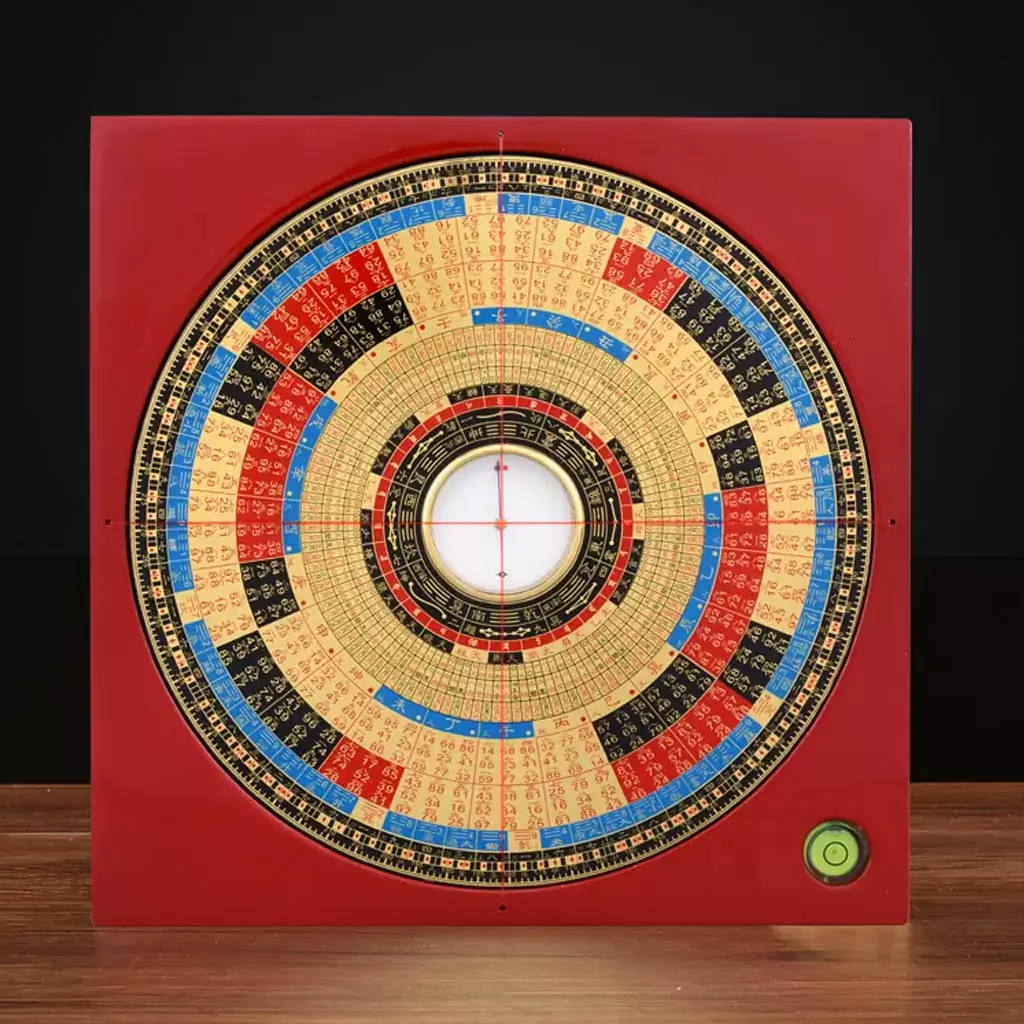
The scientific name of the compass is Luojing. It was created in the time of Xuanyuan Huangdi, and then passed through the previous sages. According to the principles of the Book of Changes and Heluo, the principle of the sun, the moon, the five stars, the seven political affairs, and the operation of the celestial and constellations were used. It is modified and manufactured to be used for azimuth determination and surveying of terrain. Most of the geographers and seamen call it “compass” or “Luogeng”, and it is rarely called “compass”.
When it comes to the use of the compass, if it is discussed in detail, I believe it will take a lot of space. Because it includes too many things, this article only talks about the simple usage.
There are many types of compasses, the commonly used ones are ternary disks, three-in-one disks, three-yuan three-in-one dual-purpose disks, easy disks, Xuankong disks and unique disks for users of each faction. However, no matter it is a compass of that school, there must be a layer in the middle with the orientation of the twenty-four mountains. From the north, they are Renzigui, Chougenyin, Jiamaoyi, Chenxunsi, Bingwuding, Weiwei. Kunshen, Gengyouxin, Xuganhai, etc. A total of twenty-four locations. If you have a compass, you can find the degrees of the compass relative to the needle as follows:
- Azimuth Gua Position Twenty-Four Mountains Angle
- Ren 337.5 – 352.5 (ie: 345+-7.5)
- True North Homzi 352.5 – 7.5 (ie: 0+-7.5)
- Dec 7.5 – 22.5
- Ugly 22.5 – 37.5
- Northeast Gen 37.5 – 52.5
- Yin 52.5 – 67.5
- A 67.5 – 82.5
- Zhengdong earthquake Mao 82.5 – 97.5 (ie: 90+-7.5)
- B 97.5 – 112.5
- Chen 112.5 – 127.5
- Southeast Sunda Sunda 127.5 – 142.5
- 142.5 – 157.5
- C 157.5 – 172.5
- Due south from noon 172.5 – 187.5 (ie: 180+-7.5)
- Ding 187.5 – 202.5
- Not 202.5 – 217.5
- Southwest Kun Kun 217.5 -232.5
- DE 232.5 – 247.5
- G 247.5 – 262.5
- Zhengxi to unitary 262.5 – 277.5 (ie: 270+-7.5)
- Sim 277.5 – 292.5
- Xu 292.5 – 307.5
- Northwest Dry Dry 307.5 – 322.5
- Hai 322.5 – 337.5

